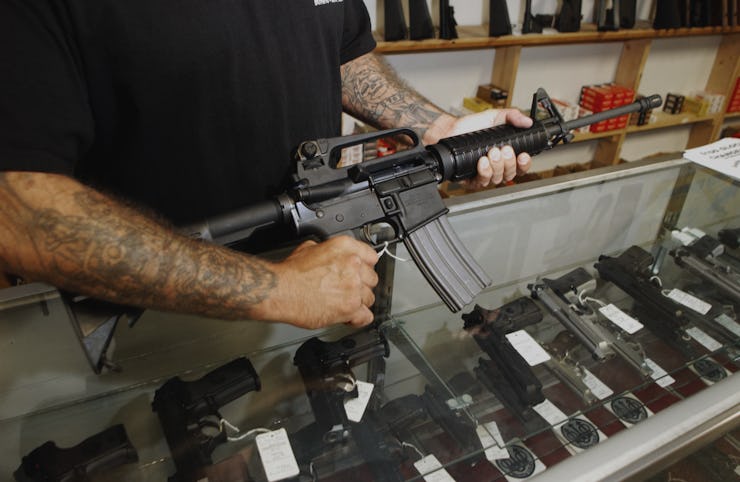7 Maps to Explain U.S. Gun Control Laws, By State
See what kind of gun regulations exist in your state.

The mass shooting is Las Vegas has brought fresh attention to the lax gun laws in Nevada, which allow people to buy and own their firearms without a background check, license, or weapon registration.
Across the fifty states and the District of Columbia, restrictions on guns vary — a lot. Idaho, Montana, Alaska each only have four gun-related state laws, according to the State Firearm Laws database maintained by the Boston University School of Public Health. On the other side of the spectrum, California and Massachusetts top the list of most provisions on record with 106 and 100, respectively.
This map shows how many provisions regulating guns exist in each state as of October 2017.
All gun laws are not created equal, though. Some laws are more hotly contested and opposed by pro-gun activists, and garner more media attention.
See for yourself how your state regulates contested gun laws around background checks, buyers with records of prison or mental illness, and other debated issues. Note that these maps don’t show the breakdown by state of every one of the 133 firearm provisions, but show six of the 14 law categories.
Assault Weapons & Large Capacity Magazines
A map showing the number of gun laws in each state that target assault weapons and large-capacity magazines.
It was discovered the Las Vegas shooter Stephen Paddock was equipped with several rapid-fire automatic guns in his attack that killed at least 58 people. This raised questions about regulations on assault weapons and guns designed to shoot multiple rounds with one pull of the trigger.
While Nevada doesn’t have a ban on assault weapons, but neither do most states, as seen in this map. Around a half million machine weapons are registered in the U.S., according to a database from the federal Bureau of Alcohol, Tobacco, Firearms and Explosives.
A federal law did exist at one point that prohibited some of these automatic guns. However, this Federal Assault Weapons Ban signed by Pres. Bill Clinton in 1994 expired in 2004 and has yet to be reinstated.
Background Checks
A map showing the number of gun laws in each state that involve background checks.
As seen in this map, less than 20 states require gun sellers to conduct some sort of background check on prospective firearm buyers.
Although a 1993 federal law called the Brady Act mandated that licensed gun dealers perform background checks through a national FBI database, there are a number of loopholes and exceptions that allow sellers to skip this requirement. Additionally, mental health records do not always show up in these checks.
High-Risk Gun Possession
A map showing the number of gun laws in each state that restrict those considered "high-risk."
Most states do have some type of prohibition on selling guns to “high-risk” individuals. People that fall into this category include those “with a history of crime, substance use, or mental health issues,” the Boston University School of Public Health says. The law is aimed at people considered dangerous and violent.
Buyer Regulations
A map showing the number of gun laws in each state that regulate the buying of guns.
These restrictions say whether interested gun buyers need a license or permit to purchase, which often comes with some sort of screening process, and whether they need to register each gun they buy.
Some states also limit through these regulations how many guns someone can buy, and age requirements for certain firearms.
Possession Regulations
A map showing the number of gun laws in each state that regulate the possession of guns.
Laws on possession are more comprehensive and widespread — only seven states do not have a single restriction on gun owners. These laws cover open carry and dictate whether guns can be in public places, including certain locations like schools and college campuses where firearms could more easily into the hands of someone without gun experience.
In some states, provisions give police the right to confiscate a gun from anyone, permit or not, that officers deem a threat to themselves or others.
Domestic Violence
A map showing the number of gun laws in each state that address matters of domestic violence.
Domestic violence disputes involving a firearm are 12 times more likely to result in death than those without a gun, according to the Law Center to Prevent Violence. These laws target those convicted of domestic violence-related crimes, and may forbid those convicted of misdemeanors or with restraining orders to own a gun.
The number of laws related to domestic violence in each state are big range — 17 provisions in California and zero in 11 other states.